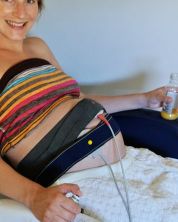 Cardiotocography Near me
Cardiotocography Near me
In obstetrics, cardiotocography (CTG) is a technical method for recording (-graphy) the foetal heartbeat using ultrasound (cardio-) and the uterine contractions (-toco-) during pregnancy, typically in the third trimester. The machine which is used to perform the monitoring is called a cardiotocograph, commonly known as a foetal monitor. Equipment used to monitor the baby's heart is placed on the tummy (abdomen) of the mother. An elastic belt is placed around the mother's abdomen. It has two round plates about the size of a tennis ball which make contact with the skin. One of these plates measures the baby's heart rate. It is normal for a baby's heart rate to vary between 110 and 160 beats a minute. This is much faster than your own heart rate, which is about 60-100 beats per minute. A heart rate in your baby that doesn't vary or is too low or too high may signal a problem. In a normal, low-risk delivery, CTG is not usually needed.However, in certain situations, continual monitoring with CTG is advised.
© 2018 Dr Sarika Jaiswal. All rights reserved